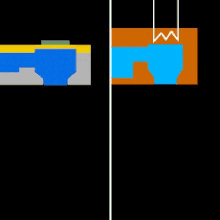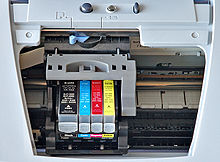Inkjet printing
[4] In the late 1970s, inkjet printers that could reproduce digital images generated by computers were developed, mainly by Epson, HP and Canon.In the worldwide consumer market, four manufacturers account for the majority of inkjet printer sales: Canon, HP, Epson and Brother.[5] In 1982, Robert Howard came up with the idea to produce a small color printing system that used piezos to spit drops of ink.The technology has been extended and the 'ink' can now also comprise solder paste in PCB assembly, or living cells,[7] for creating biosensors and for tissue engineering.[8] Images produced on inkjet printers are sometimes sold under trade names such as Digigraph, Iris prints, giclée, and Cromalin.[9] Inkjet-printed fine art reproductions are commonly sold under such trade names to imply a higher-quality product and avoid association with everyday printing.Another advantage is freedom from nozzle clogging as the jet is always in use, therefore allowing volatile solvents such as ketones and alcohols to be employed, giving the ink the ability to "bite" into the substrate and dry quickly.The basic problem with inkjet inks is the conflicting requirements for a coloring agent that will stay on the surface versus rapid bleed through the carrier fluid.[11] Desktop inkjet printers, as used in offices and homes, tend to use aqueous ink[11] based on a mixture of water, glycol and dyes or pigments.In the consumer space, fixed-head printers are manufactured primarily by Epson and Canon; however, many more recent Hewlett-Packard models use a fixed head, such as the Officejet Pro 8620 and HP's Pagewide series.Even when the head is capped, this seal is not perfect, and over a period of several weeks the moisture (or other solvent) can still seep out, causing the ink to dry and harden.In comparison to technologies like thermal wax, dye sublimation, and laser printing, inkjets have the advantage of practically no warm up time, and often lower cost per page.These allow the inkjet printer to compete with the silver-based photographic papers traditionally used in black-and-white photography, and provide the same range of tones: neutral, "warm" or "cold".Leading companies and innovators in hardware include HP, Epson, Canon, Konica Minolta, FujiFilm, EFi, Durst, Brother, Roland, Mimaki, Mutoh and many others worldwide.Inkjet printing head nozzles can be cleaned using specialized solvents, or by soaking in warm distilled water for short periods of time (for water-soluble inks.)In the US the Magnuson–Moss Warranty Act is a federal law which states that warrantors cannot require that only brand name parts and supplies be used with their products, as some printer manufacturers imply.[27] If low-quality paper is used, it can yellow and degrade due to residual acid in the untreated pulp; in the worst case, old prints can literally crumble into small particles when handled.Because the ink used in many low-cost consumer inkjets is water-soluble, care must be taken with inkjet-printed documents to avoid even the smallest drop of moisture, which can cause severe "blurring" or "running".[citation needed] In extreme cases, even sweaty fingertips during hot humid weather could cause low-quality inks to smear.Resin or silicone protected photopaper is widely available at low cost, introducing complete water and mechanical rub resistance for dye and pigment inks.[citation needed] Inkjets use solvent-based inks which have much shorter expiration dates compared to laser toner, which has an indefinite shelf life.[citation needed] By contrast, laser printers do not have printheads to clog or replace frequently, and usually can produce many more pages between maintenance intervals.Both technologies have improved dramatically over time, although the highest-quality giclée prints favored by artists use what is essentially a high-quality specialized type of inkjet printer.[36] In Lexmark Int'l v. Static Control Components, the United States Court of Appeals for the Sixth Circuit ruled that circumvention of this technique does not violate the Digital Millennium Copyright Act.Kodak claimed that consumers could save up to 50 percent on printing by using its lower-cost cartridges filled with the company's proprietary pigmented colorants while avoiding the potential problems associated with off-brand inks.Supertank printers generally ship with full bottles of ink in the box, allowing up to two years of printing before the tanks needs to be refilled.The major suppliers for professional high-volume, wide- and grand-format printers include: EFI,[44] LexJet, Grapo, Inca, Durst, Océ, NUR (now part of Hewlett-Packard), Lüscher, VUTEk, Scitex Vision (now part of Hewlett-Packard), Mutoh, Mimaki, Roland DG, Seiko I Infotech, IQDEMY, Leggett and Platt, Agfa, Raster Printers, DGI and MacDermid ColorSpan (now part of Hewlett-Packard), swissqprint, SPGPrints (formerly Stork Prints), MS Printing Systems and Digital Media Warehouse.The editing options are usually somewhat advanced, allowing the user to crop photos, remove red eye, adjust color settings as well as other functions.Compact photo printers typically feature a large number of connection options, including USB and most memory card formats.Inkjet printers, especially models produced by Dimatix (now part of Fujifilm), Xennia Technology and Pixdro, are in fairly common use in many labs around the world for developing alternative deposition methods that reduce consumption of expensive, rare, or problematic materials.










History of printingWoodblock printingMovable typeIntaglio (printmaking)Printing pressEtchingMezzotintRelief printingAquatintLithographyChromolithographyRotary pressHectographOffset printingHot metal typesettingMimeographDaisy wheel printingPhotostat and rectigraphScreen printingSpirit duplicatorDot matrix printingXerographySpark printingPhototypesettingDye-sublimationLaser printingThermal printingSolid ink printingThermal-transfer printing3D printingDigital printingcomputer printingdigital imagelaser printersHewlett-Packardreproduce digital imagesBrothersolid inkink jet material depositionpiezoelectricsolder pastePCB assemblybiosensorstissue engineeringtrade namesIris printsgicléeLord Kelvinsyphon recorderchart recordersSiemensRune ElmqvistPlateau-Rayleigh instabilityvolatileketonesLexmarkphotolithographytrade namesurface tensionpigmentsBrother Industriespiezoelectric materiallead zirconium titanateoperating costThermoplastic3D printerglycolleathercolor gamutlaminationPigmentultravioletarchival qualityvolatile organic compounds (VOCs)vapor pressuresmonomerssublimation dyespolyestersublimatewaxy compoundsHot-melt inksdisposablelarge format printersink cartridgeconsumablesstepper motorspittoonwide-format printerContinuous ink systemSupertank printersdot matrixdaisywheel printersthermal waxdye sublimationdevice drivercolor mappingmicrochipself-refill kitsreverse-engineeredConsumer ReportsWilhelm Imaging Researchdouble-blindMagnuson–Moss Warranty Actarchivalacid-free paperhighlighterprinted circuit boardscovers the chiprazor and blades modelproduct tyinganticompetitivemicrochipsanti-trustStaplesLexmark Int'l v. Static Control ComponentsUnited States Court of Appeals for the Sixth CircuitDigital Millennium Copyright ActEuropean CommissionEastman Kodaksupertank printerregion codesthose of DVDsvariable datadigital textile printingprepressprinting